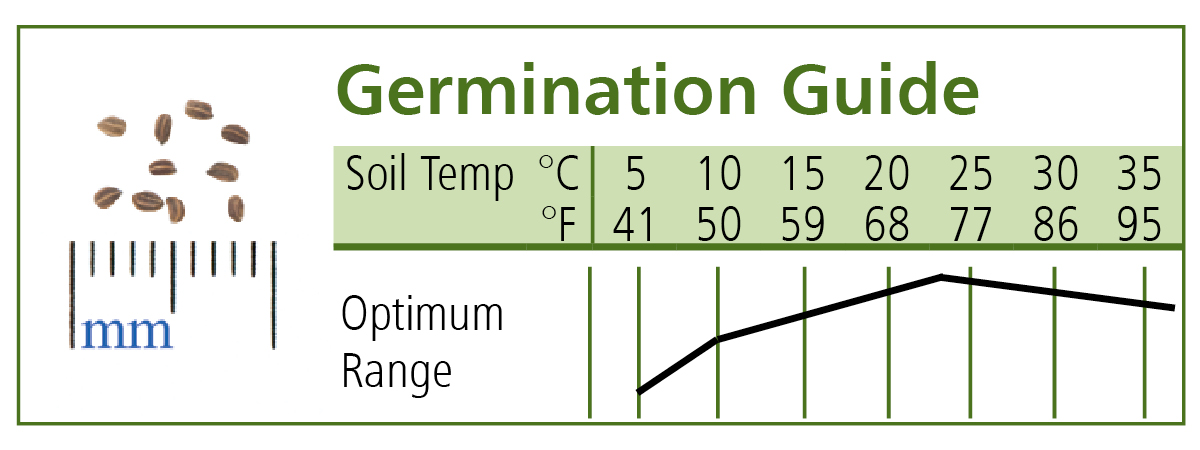Kelvin
Pelleted (F1) Celery Seed
Product ID: 4198JP
A farmer favorite. Conventional seed with NOP-compliant pelleting.
Thick, juicy, and succulent. Petioles and leaves are a healthy dark green. Stalks hold well in the field. Kelvin performs well under heat and moisture stress and in soils of average fertility. More upright and uniform than Conquistador, which it replaced. Pelleted seed. Avg. 150,000 seeds/lb. Packet: 250 seeds.
https://www.johnnyseeds.com/vegetables/celery-and-celeriac/celery/kelvin-pelleted-f1-celery-seed-4198JP.11.html
Size
Price
Quantity
Availability
SCIENTIFIC NAME: Apium graveolens
CULTURE: Celery and celeriac require fertile soils with a pH range of 6.0-7.0. This crop needs a consistent supply of moisture throughout the season for optimum flavor and yield.
PELLETED SEED: If using pelleted seed: for best results, we recommend consistent soil moisture during the germination period. Pellets are made of inert NOP-compliant materials. Our celery and celeriac pellets are both size 8. Pelleted seed must be kept cool and dry prior to planting, and should be used within one year of purchase.
GROWING SEEDLINGS: Sow in early March or 10–12 weeks before transplanting outdoors. Sow 6 seeds/inch, 1/8" deep, in 20-row, open flats or plug trays. Seeds require light to germinate. Keep soil moist and temperatures 70–75°F (21-24°C) if possible. Seedlings emerge in 2–3 weeks and then temperature can be reduced to 60–70°F (16–21°C).
TRANSPLANTING: When seedlings have 2 true leaves, transplant to 1 1/2" plug trays. Transplant outdoors in late May to mid-June when weather is warm and settled. Set plants 6–8" apart in rows 24–36" apart. Irrigate to keep soil moist.
BOLTING: Caused by exposure of young plants to temperatures below 55°F (13°C) for 10 days or more. When hardening plants before transplanting out, reduce water for 7–10 days. Do not harden off celery plants by lowering temperatures.
DISEASES AND PESTS: For leaf blights, rotate crops. Ensure adequate soil calcium and water to prevent blackheart. For Celery Mosaic (mottled leaves, twisted stems, dwarfing), control aphids.
HARVEST: Celeriac: Late summer through fall at a 3–5" diameter. Celery: Cut stalks when they are of edible size but before becoming pithy. Stalks may be blanched if desired by hilling up with soil or by placing paper collars around plants.
STORAGE: After harvest remove field heat by dunking plants in cold water. Store sound heads/roots at 32°F (0°C) with 98–100% relative humidity. Celery will store for 1–2 months and celeriac 6–8 months. CAUTION: In rare instances, contact with the foliage can result in a severe rash. When working with this crop on hot, sunny days, we recommend wearing long sleeves and long pants and washing any exposed skin surfaces as soon as possible after contact.
SEED SPECS: SEEDS/OZ: See individual varieties.
PACKET: 250 seeds.
CULTURE: Celery and celeriac require fertile soils with a pH range of 6.0-7.0. This crop needs a consistent supply of moisture throughout the season for optimum flavor and yield.
PELLETED SEED: If using pelleted seed: for best results, we recommend consistent soil moisture during the germination period. Pellets are made of inert NOP-compliant materials. Our celery and celeriac pellets are both size 8. Pelleted seed must be kept cool and dry prior to planting, and should be used within one year of purchase.
GROWING SEEDLINGS: Sow in early March or 10–12 weeks before transplanting outdoors. Sow 6 seeds/inch, 1/8" deep, in 20-row, open flats or plug trays. Seeds require light to germinate. Keep soil moist and temperatures 70–75°F (21-24°C) if possible. Seedlings emerge in 2–3 weeks and then temperature can be reduced to 60–70°F (16–21°C).
TRANSPLANTING: When seedlings have 2 true leaves, transplant to 1 1/2" plug trays. Transplant outdoors in late May to mid-June when weather is warm and settled. Set plants 6–8" apart in rows 24–36" apart. Irrigate to keep soil moist.
BOLTING: Caused by exposure of young plants to temperatures below 55°F (13°C) for 10 days or more. When hardening plants before transplanting out, reduce water for 7–10 days. Do not harden off celery plants by lowering temperatures.
DISEASES AND PESTS: For leaf blights, rotate crops. Ensure adequate soil calcium and water to prevent blackheart. For Celery Mosaic (mottled leaves, twisted stems, dwarfing), control aphids.
HARVEST: Celeriac: Late summer through fall at a 3–5" diameter. Celery: Cut stalks when they are of edible size but before becoming pithy. Stalks may be blanched if desired by hilling up with soil or by placing paper collars around plants.
STORAGE: After harvest remove field heat by dunking plants in cold water. Store sound heads/roots at 32°F (0°C) with 98–100% relative humidity. Celery will store for 1–2 months and celeriac 6–8 months. CAUTION: In rare instances, contact with the foliage can result in a severe rash. When working with this crop on hot, sunny days, we recommend wearing long sleeves and long pants and washing any exposed skin surfaces as soon as possible after contact.
SEED SPECS: SEEDS/OZ: See individual varieties.
PACKET: 250 seeds.
Johnny's is committed to your success, every step of the way.
We want you, our customer, to be 100% satisfied with all of our seeds, tools, and supplies.
If anything you purchase from us proves unsatisfactory, we will either replace the item or refund the purchase price.




